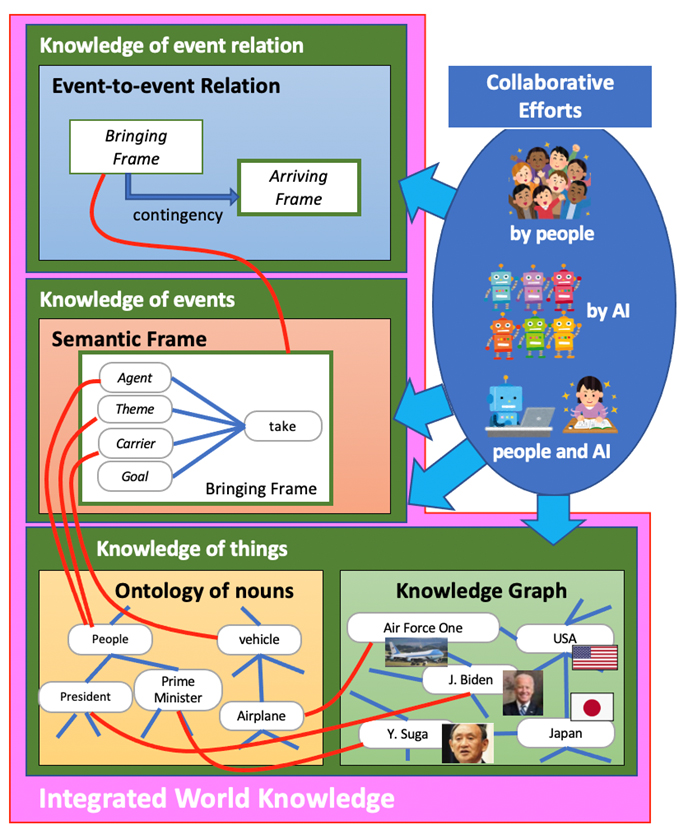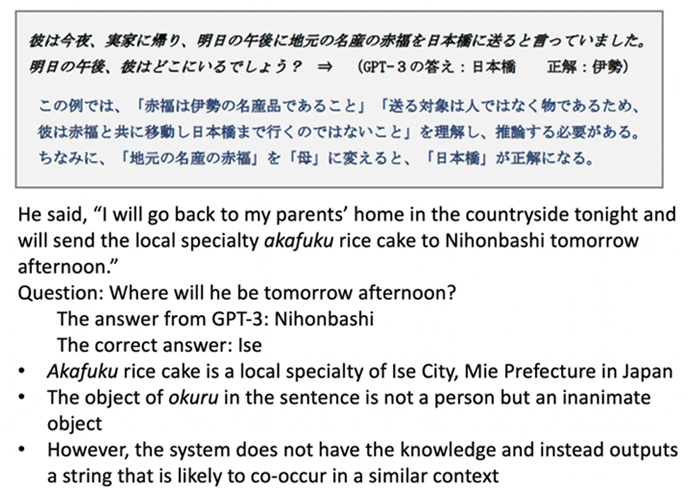Research outcomes of the Program for the Advancement of Next Generation Research Projects
Faculty of Science and Technology
Kyoko Ohara
Researchers
- Kyoko Ohara (Keio University)
- Daisuke Kawahara (Waseda University)
- Satoshi Sekine (Center for Advanced Intelligence Project, RIKEN)
- Ryohei Sasano (Nagoya University)
Research Objective
- To realize AI systems that truly understand human language, this project sought to construct an "integrated world knowledge" and combine the knowledge with deep learning methods.

Figure 1:
Overview of Integrated World Knowledge and the scope of the project
(Credit: RIKEN)
Our Aim of Research
- Among the three kinds of knowledge that make up the "integrated world knowledge" described in Figure 1, namely, "knowledge of things," "knowledge of events," and "knowledge of event relations," we focused on constructing "knowledge of events," i.e., knowledge about situations, events, and sequences of events, which involve various entities and relations among entities. We aimed to describe these as semantic frames.
Research Methods
- Cognitive linguistics hypothesizes that humans acquire a vast number of semantic frames as schematized background knowledge through their various experiences. We used semantic frames as defined in FrameNet and Japanese FrameNet.
- "Knowledge of events" were constructed by using two kinds of collaborative efforts:
- Collaboration among humans: To acquire human knowledge efficiently, the project used crowdsourcing, trained annotators, and linguists. The trained annotators may intervene, when crowdsourcing cannot come up with the appropriate knowledge. Ohara was responsible for designing the structures and the details of the knowledge.
- Collaboration between AI and humans: When knowledge acquired by an AI system contains mistakes, humans corrected them to improve the quality of the knowledge. To efficiently obtain feedback from the limited human resources, we investigated how AI can select what output needs to be evaluated based on its confidence.
Achievements
- We succeeded in creating approximately 1,000 semantic frames pertaining to "knowledge of events."
- Our research group has yet to create an AI system that incorporates our "knowledge of events," but our knowledge should be able to correctly answer the question "Where will he be tomorrow afternoon?" given in the context below, whereas GPT-3 cannot:

Figure 2:
Example of Future Application
(Credit: Keio University)
Selected Publications in English
- Ohara, Kyoko. (2022). Combining two kinds of frame knowledge with crowdsourcing. Kristian Bensenius (Ed.) Valency and constructions: Perspectives on combining words. pp. 131-154. Gothenburg: University of Gothenburg.
- Kosuke Yamada, Ryohei Sasano, Koichi Takeda. (2021). Semantic Frame Induction using Masked Word Embeddings and Two-Step Clustering. Proc. of ACL-IJCNLP 2021.
- Ohara, Kyoko. (2021). Crowdsourcing frame disambiguation in Japanese FrameNet: what it says about annotation and frame assignment. 11th International Conference on Construction Grammar (ICCG11).
- Kazuma Omura, Daisuke Kawahara, Sadao Kurohashi. (2020). A Method for building a commonsense inference dataset based on basic events. Proceedings of EMNLP2020.
- Satoshi Sekine, Masako Nomoto, Kouta Nakayama, Asuka Sumida, Koji Matsuda, and Maya Ando. (2020). Overview of SHINRA2020-ML Task. Proceedings of NTCIR-15 Conference.
Future Direction of Research
-
In the future, we aim to extend our unified world knowledge to include the two types of knowledge (cf. Figure 1 above):
- 1) Knowledge of things: knowledge about entities that exist in the world. This repository of knowledge of things will be linked to knowledge of events via semantic frames.
- 2) Knowledge of event relations: knowledge about relations between events, such as causal relations and contingent relations. This knowledge base will be described as symbolic knowledge and will be linked to knowledge of events via semantic frames.
Keio University Program for the Advancement of Next Generation Research Projects
The Keio University Program for the Advancement of Next Generation Research Projects subsidizes research costs with the aim of finding solutions to challenges and of promoting global academic research in order to allow Keio University faculty members to establish a presence as core researchers.